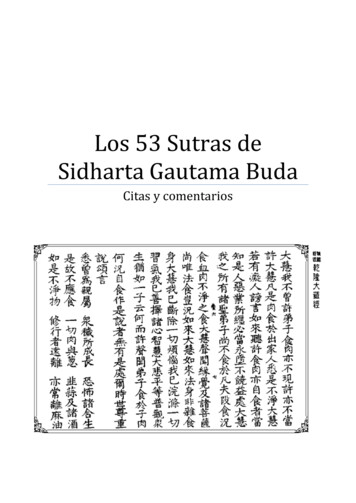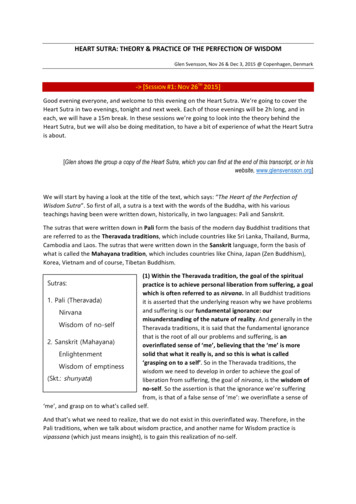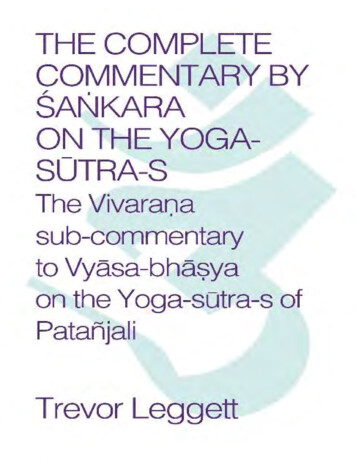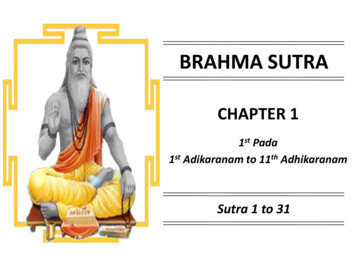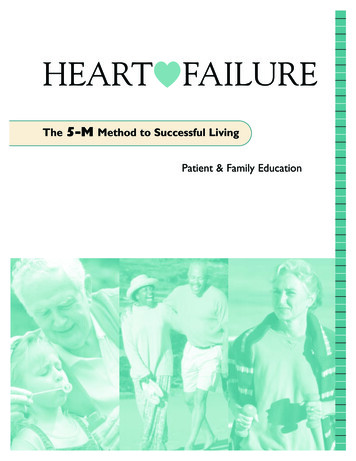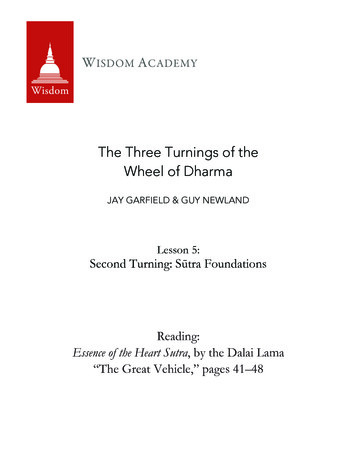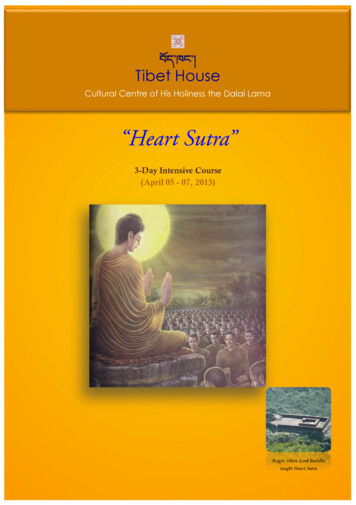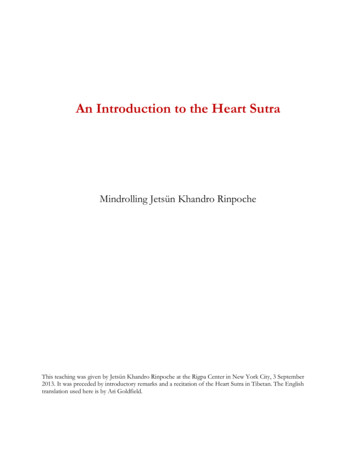
Transcription
An Introduction to the Heart SutraMindrolling Jetsün Khandro RinpocheThis teaching was given by Jetsün Khandro Rinpoche at the Rigpa Center in New York City, 3 September2013. It was preceded by introductory remarks and a recitation of the Heart Sutra in Tibetan. The Englishtranslation used here is by Ari Goldfield.
1An Introduction to the Heart SutraThe topic of the Heart Sutra is one of the most extraordinarily complex and profound topics. So, Ithought it was funny enough asking me to say something about it (laughter), but to want to finish itin one evening—that’s even funnier or should I say extraordinary (more laughter). But let’s see whatwe can do.There are many wonderful translations of the mahayana text that we fondly call The Heart Sutra, orPrajnaparamita Sutra, as it is also known. If you have your own copy of the text, you can refer to it aswe go along.Anyone who has any understanding of this text knows that it is not particularly material for study.The Heart Sutra is in part a recitation—not so much a prayer, as a verbal reminder of thequintessence of Buddhadharma. In this sense, it could be said to be the very core of the Buddhistteachings. When newcomers ask about what Buddhadharma is or what Buddhists are trying to do, agood answer would be to hand them a copy of the Prajnaparamita text. Of course, when they readthat there are no eyes, no ears, no mouth, no nose, and so on, they might find this a bit “over thetop.” They might say they don’t understand this at all—which is precisely the point! That’s whatBuddhism is trying to do. (Laughter)I say this is because the Heart Sutra is based on Arya Avalokiteshvara’s own deep reflection on theperfection of wisdom. To study the Heart Sutra you have to study Madhyamika and the great worksof the masters such as Nagarjuna, Chandrakirti, Aryadeva, and so forth. The Madhyamika study ofthe views allows you to go into the different versions of the Prajnaparamita Sutra. The sutra we arereferring to here is one of the shortest sutras. Some much longer ones are sutras in 10,000 stanzas,15,000 stanzas, 18,000 stanzas, 25,000 stanzas, 80,000 stanzas, and 100,000 stanzas—along withvolumes and volumes of elaborate commentaries. All these versions are concentrated in the formthat we call the Heart Sutra.The Title of the TextThe full title of the Heart Sutra in Sanskrit is Bhagavati Pragyanaparamita Hridaya Sutra. Because theterm bhagavati has a strong connotation of “goddess” or “mother principle,” prajnaparamita is oftenreferred to as the “Mother of all Buddhas,” and is given the form of a female deity. But if you gobeyond the form, the Sanskrit word bhagavati—which is actually two words—has a much deepersense of “nature” and something “in union.” The bhagavati principle is the union of two forces,pristine wisdom and skilful means, whose inseparability is the fundamental nature. Hence, the term“bhagavati.”Prajna, which is how most of you pronounce the Sanskrit pragyan, is often translated as “wisdom.”And paramit, as in prajnaparamita, refers to the “wisdom beyond the realm of conventional reality.”If seen within the framework of intellectual knowledge, prajnaparamita would have the fault ofbecoming conceptual. And because a concept is always the basis of an argument, you would thenhave to argue about whose wisdom is better, and why my wisdom or your wisdom is better.Ultimate wisdom is beyond the realm of conventional reality and conventional intellectualization.Thus, prajnaparamita has the connotation of being the peak, or summit, of wisdom.The third word, hridaya, often pronounced hrideh, means “heart.” The heart, or core, is very directand simple. The last word, sutra, is a “chain,” or “continuum.” So the title, Bhagavati PragyanaparamitaHridaya Sutra, refers to the continuum of the essence, or nature, beyond conventional reality and 2014 Mindrolling International / Dharmashriwww.lotusgardens.org
2intellectualization. The deep samadhi that Arya Avalokiteshvara rested in was the continuum of thatcore essence: the nature of all phenomena, beyond the needs, confines, and limitations ofconventional reality.The last two words of the title, Hridaya Sutra, or Heart Sutra, then became the prevalent nickname ofthis very exceptional text.The text consists of three main characters: the bodhisattva Arya Avalokiteshvara, Shariputra, and theBuddha, himself. It is basically a dialogue, or question-and-answer, between Arya Avalokiteshvaraand the protagonist, Shariputra. This is how the Heart Sutra comes about: the responses of AryaAvalokiteshvara to the questions of Shariputra are the Heart Sutra.The Buddha’s SilenceThe Buddha is present throughout the text, but he doesn’t speak. Except for the conclusion of thetext where the Buddha says, “Excellent, excellent. This is how it is.” thus affirming the absolutetruth of what was said, he is silent. The Buddha’s silence is one of the most remarkable aspects ofHeart Sutra and forms a fundamental principle of Buddhadharma.Now, those of you who have practiced Buddhism know that many different approaches are taughtaccording to the diverse capacities and potentials of human beings. These differences do invade whatwe call Buddhist philosophy, which is taught in diverse ways; and all the various practices, paths,philosophies, and teachings are relevant. But just as many rivulets collect into one ocean, the manydiverse aspects of Buddhadharma all gather into the single ocean of silence.This is not a passive silence. Silence, here, is a term used for the insight and courage to go beyondconventional thinking—particularly the conventional assumption that answers are found on thebasis of intellectualization.The Samadhi of the Perfection of WisdomThe first verse of the text begins with “Thus have I heard” and usually ends with “He saw the fiveskandhas to be empty of nature.” It refers, in particular, to Arya Avalokiteshvara in deep samadhi.What kind of deep meditation or introspection was Arya Avalokiteshvara abiding in? The mahayanaMadhyamika teachings call that samadhi “seeing” or “recognizing” the fundamental nature.Now, it is always very difficult to use the word seeing when speaking about a topic such as the HeartSutra. The problem being that the English word seeing depends upon a subject and object—andwith a subject comes a seer, with an object there is something to be seen.Seeing, here, means “seeing just as it is,” independent of a subject or object. Without thatmisunderstanding, seeing is just the freedom to see. “Realizing” is another word we often use inBuddhist philosophy. This word must also be used without any connotation of a realizer orsomething to realize. So, too, the word “awakening.”The samadhi that Avalokiteshvara was abiding in was an awakening without an awaken-er oranything to awaken one. His awakening was to recognize the basic, fundamental nature of self andall phenomena “as it is,” without any kind of projection or assumption. Seeing the true nature of selfand of all perceptible phenomena and not deviating from that is called “Avalokiteshvara abiding inthe samadhi of the perfection of wisdom.” 2014 Mindrolling International / Dharmashriwww.lotusgardens.org
3What the first verse is referring to is an awareness of the fundamental nature of things—andAvalokiteshvara’s undistracted recognition of this, which is referred to as prajnaparamita or, looselytranslated, the “perfection of wisdom.”The Path of Authentic BuddhadharmaThe point here is to understand that what you are trying to recognize when you contemplate orstudy the Heart Sutra is none other than what Avalokiteshvara was trying to see: the true nature ofself and others—and then resting in that awareness of natural reality.Thus the Prajnaparamita Sutra became not only the foundation of the mahayana teachings, but alsothe holder of the core essence of all Buddhist teachings. So, when reciting and reflecting on theHeart Sutra, remember to evoke its meaning in your meditation. This will allow you to really walkthe path of authentic Buddhadharma.If this is not understood then, sadly, you may quite likely become a victim of all the superficialdharma so prevalent today. Not that there is any intention to bring about modification or fabricationof dharma, but we all know that dharma is handled by people like you and I. We invest a lot ofourselves into the path of practice, and the tendency to contort the dharma to suit our ownexpectations is a difficult seduction to resist. At what point do we get caught in the trappings ofsuperficial dharma—which is what’s happening today? This must be very carefully observed andexamined.In the beginning, most people searching for spiritual insight have very authentic motivation. Ofcourse, there are always those with nothing better to do, who think “Maybe I should become aBuddhist for a while,” and those who come into Buddhism reluctantly because of parents, brothers,sisters, spouses, or partners who won’t marry them unless they do. Several friends of mine havegrudgingly become meditators because that was their partners’ condition for marriage. But those arethe exceptions.Most people searching for some spiritual insight begin with very authentic motivation. Thatmotivation may not be very well formulated or articulated in their minds. If you ask them why theymeditate, they may say they don’t know. But even in the inability to articulate it, there is a deeplonging for something pure, something good that they would like to realize and achieve.However five, ten, or fifteen years into it—things get worse. As you “age” in the Buddhadharma,you can get sidetracked. That first intention that was so pure it couldn’t even be articulatedsomehow decreases or become seduced by the agendas and ambitions we bring into meditation.Restless Mind of Ambitions and AgendasUnless your practice is constantly analyzed, examined, and made sure of—through your own effortsand through the blessings of the gurus and the many teachings you have received—it is very easy toget caught in ambition on the path of practice.The very simple ambitions that prevail in the East are about having a long life with good health,wealth and prosperity, and no obstacles. They are very orthodox and systematic in their approach: abuddhafield would be best; but if not, then a good next life nearer to the teacher, with a betterchance, an earlier start. This is the “wish list.” 2014 Mindrolling International / Dharmashriwww.lotusgardens.org
4In the West it is a bit different. Interestingly, when I first came to the West, people were constantlytelling me to be sure to give them “Buddhadharma,” not Tibetan culture. They felt that Tibetanswere very orthodox and very theistic in their approach. What attracted westerners to the path ofdharma was the nontheistic approach. Very well. That’s very nice. (Laughter)Twenty-five years later, however, the gears seemed to have shifted. While not as dogmatic or theisticas the East, westerners today come up with all these feelings: feelings of “connections,” feelings ofwell being—and that “goodness” thing you have, a sort of blissed-out state. Of course, one can’tgeneralize, but you now seem to be doing much worse than the Tibetans. We at least think about thenext life! You are content with some sensory experience in this life. It doesn’t even go very far intoold age. It is all about now. Isn’t it? (Laughter)Beyond just joking about this, if you look at what is happening, East and West, it is very sad. Thereal power of dharma—which happens to be a path of cessation of suffering, not only for oneselfbut for all—is not being tapped into. Instead, your whole reason for engaging in practice getsseduced into some singular and very temporary ambition.Of course, what Buddhist meditator does not want cessation of suffering for all sentient beings? Weall talk about liberating sentient beings. It is a good thought. But do take time to look into your mindand see how convinced you are about this. Will it happen? You don’t know—and actually you don’tmuch care, as long as you have a good session. As long as your mind is relaxed and wise, as long asyou can handle some emotional problem more sensibly, like a kind of self-therapy that will save youfrom having to pay a therapist.The point here is that superficial dharma is very limited. Of course, you may say, “I’m not in this toliberate others or to gain enlightenment for myself. That’s not my criteria. I would be very satisfiedwith a basically mindful life that serves as a foundation of happiness for myself and others.” Irecently met a lady who said just that: “I’m not looking for enlightenment. It’s too tough and I don’tthink I can do it. I just want some happiness for myself, my family, and all others who relate to me.”That is wonderful. There is a level of honesty in that. To be honest about a relative, systematic,nontheistic-but-actually-theistic approach is fine. And I appreciate the mushrooming of dharmacenters that provide such methods—the same way we have Pilates and yoga classes, meditationclasses, singing classes, and all those laughter classes. Those are all very good.My problem is with those who, like myself, claim to understand something about enlightenment,cessation, and absolute truth, but who can’t cut ties with the subterfuge of personal ambition. We sitin meditation pretending that if we don’t think about it, ambition isn’t there. We’re like the childwith chocolate cake all over its face, claiming not to know who ate the cake.We need to observe ourselves as we sit in meditation trying to work with truth, nonattachment,selflessness, and letting go. Is that moment of compassion beyond a self-cherishing agenda reallyfree of the momentum of restlessness? This restless momentum is the ambition of sustaining theself—to such a degree that we can’t let go of thinking I see realization; I am generating compassion;or, compassion is difficult—or easy—for me. Everything that should be without an agenda of a selfis actually revolving like a satellite around the self’s ambition and agenda.At this point, there is no comprehension of the very quintessence of the mahayana teachings.Reciting the Heart Sutra allows you to bring that back into your own reflection. 2014 Mindrolling International / Dharmashriwww.lotusgardens.org
5Traditionally, especially in the Japanese tradition, the Heart Sutra as recited as often as possible.There is also a wonderful practice of writing the Heart Sutra in beautiful calligraphy. Oftentimes ifyou are very used to reading it, you may be just muttering words without really reflecting on them.In the practice of writing out the Heart Sutra—no matter which of the various traditions you use—each word evokes awareness within you. This allows you to not be seduced into superficialapproaches to Buddhadharma, which amount to nothing but a tremendous waste of your effort andpotential.The Prajnaparamita Sutra refers back, again and again, to the quintessential Buddhadharma ofremaining in deep understanding of the natural truth—and not doing anything much beyond that.Resting Mind in Natural TruthResting the mind in a deepened awareness of the natural truth is the whole emphasis of all thevarious Buddhist teachings, whether in the Theravada tradition, the Zen tradition, or particularly theanalytical approach of shamatha, vipashyana, and mahayana Madhyamika school. We see it later,with further elaboration, in the various trainings of Mahamudra and Dzogchen. The emphasis is onnot doing anything much beyond resting the mind in awareness of the nature of things as they trulyare. From recognizing this absolutely come many different anecdotes and references.One such reference to keep in mind is in the Vajracchedika Sutra, or Diamond Sutra, as it is morepopularly known. The Diamond Sutra closely resembles the Heart Sutra teachings. In it, Subhutistruggles to understand the reality of perception. His reflection and analysis have to do with thenature of mind and perceptible objects. What is the nature of the perceiving mind? What is therelationship between the perceiving mind and perceived objects? At the conclusion of the text, thereis a conversation between Subhuti and Buddha Shakyamuni that is considered to be the very soul ofthe Diamond Sutra. After a whole afternoon in conversation, the Buddha asks Subhuti, “Have youunderstood?” Subhuti answers, “I have understood.” Then the Buddha asks, “Has the teachertaught today?” And Subhuti says, “No, you have not taught.” To which the Buddha replies,“Absolutely right. You have finally understood.”In the vajrayana tradition, Tilopa says that ultimate abiding in the “nature as is” requires themeditator not to meditate, not to “see,” not to think, not to express, not to perceive, not torecognize or know. Simply abide.In the Dzogchen tradition, we find Padmasambhava saying the same thing. When Yeshe Tsogyalasks how to practice the dharma authentically, and how to be absolutely sure one’s meditation is notfabricated dharma, Padmasambhava replies:Do not do anything: do not follow, do not think, do not conceptualize,do not articulate or express anything.Do not do anything.With nothing to see, nothing to follow, nothing to abide in—Simply let be.What Padmasambhava is specifically pointing out here is that one is not enlightened throughfabricated dharmas. One needs to understand dharma beyond fabrication. One will never beenlightened through indicated dharma; one needs a dharma beyond indications. One will never beenlightened through expressed dharma; one needs a dharma beyond expression. 2014 Mindrolling International / Dharmashriwww.lotusgardens.org
6Throughout Buddhist history, all of the teachings and various methods emphasize this one thing:ultimately, you will understand when you can let go and abide in a state of absolute openness andnatural ease.Giving Yourself a BreakTo understand the core essence Buddhadharma, the only thing asked of youis to give yourself a break. Give yourself a break from thinking you haveto do it, see it, achieve it, change it, or bring it to fruition. Give a break to thedeep arrogance that assumes this world wouldn’t know how to function withoutyou . All the Buddhist teachings and methods come to this single point:Just sit still.For someone new to these teachings, how could one simplify all that we’ve spoken of so far? Tounderstand the core essence Buddhadharma, the only thing asked of you is to give yourself a break.Give yourself a break from thinking you have to do it, see it, achieve it, change it, or bring it tofruition. Give a break to the deep arrogance that assumes this world wouldn’t know how to functionwithout you. You may not think about your world that way, but watch your behavior patterns. Thisis why all the Buddhist teachings and methods come to one single point: just sit still.Now, this sounds nice. But what is really being said here is that our physical movement isn’t neededall that much. Without it, you may suppose nothing would function. But try it. You will see thatothers around you are happier when you do not interfere in their lives. When you just sit still and,most importantly, just keep quiet. Silence is the best thing you can do for anyone else. (Laughter)The instigating factor behind all of our interfering is the chattering mind. Give your mind a break.Free it from the supposition that its interference and modifications are constantly needed.The momentum of restlessness and discontent is created by apprehension. You assume you wouldbe at a loss without that restlessness, so you provide yourself with situations in which you areconstantly restless. But they don’t actually work the way you hoped, which creates furtherdiscontent, which then boomerangs back as further interference and restlessness.As a meditator, watch this constant sense of discontent and restlessness. Watch the anxiety thatprojects itself in the form of a speedy body, speedy speech, and speedy mind. This is basically whatwe are and how we live our lives—and what better example of this restless body, speech, and mindthan being here in New York?All this is in the hope of satisfying your quest for happiness, contentment, peace, and fulfillment.When it doesn’t, you become insecure. You then try to evade that insecurity by more restlessness ofbody, speech, and mind. Seeing this rhythm, someone like Arya Avalokiteshvara begins to questionit. Is it the outward movement that proliferates restlessness? Are you drowning out your basic sanityand subsuming your awareness in a powerful whirlwind of activity? If so, it will probably not fulfillyour aspiration for peace and harmony.The Four Seals: Keys to Genuine PeaceA questioning mind such as that of Arya Avalokiteshvara begins to ponder the words of theBuddha, who presented the Buddhadharma of his own realization through the “four seals”:1. All phenomena are impermanent by nature. 2014 Mindrolling International / Dharmashriwww.lotusgardens.org
72. All contaminated phenomena are the sources of discontentment.3. All phenomena are devoid of an inherent permanent existence, or self.4. Cessation or nirvana is utter peace.When Arya Avalokiteshvara was in deep reflection, he was probably contemplating the path of thefour seals. Through contemplating the four seals, the mind begins to truly understand thefundamental nature of things as they are: they are impermanent in nature; they are not singularentities; suppositions to the contrary lead to restlessness and discontent; and freeing oneself fromthese three misunderstandings is the key to genuine peace. The unfolding of this understandingmanifests in one’s realization as “samadhi.” This is the samadhi that our Arya Avalokiteshvara wasin. When reflection on the four seals manifests as an awakening to the true nature, it is said to beprajnaparamita.The four seals are explained from the Madhyamika perspective as follows.1. All Phenomena are Impermanent by NatureIn the Madhyamika teachings, the four seals are taught by simply observing things. Take your hand,for example. Without reflecting on the truth of the four seals, you would suppose it to bepermanent. The hand you have today is the same hand you had yesterday and will have tomorrow. Itis the hand you were born with. But that’s not true, is it? You can see that the hand you were bornwith and the hand you had twenty-five years ago are definitely not the same.Reflect upon the first seal and ask yourself: Are the things you think of as permanent reallypermanent? Look at your own hand and see. From a Buddhist perspective, this is not a denigrationof the hand; it is a very gentle way of appreciating the fact that the rather wrinkled hand of today isnot the hand of twenty-five years ago. There is a sense of change.2. All Contaminated Phenomena are Sources of DiscontentFrom the Madhyamika perspective, looking at the hand and even calling it a “hand” is actually cruel.It is very ungenerous of you to not understand the wholeness of the situation. You would get veryupset at work, for example, if a manager took credit for the hard work of many people. You wouldsay, “That’s not just!” and hold up signs and go on strike. That is an analogy for the injustice ofcrediting the hand with being a hand, without taking the wholeness of the situation intoconsideration. That designation could only being given because (1) you don’t have time to thinkmore about it, or (2) it’s the most convenient thing to say. When we’re in a rush, we say things like“you look good” or “you’re very bad,” without considering whether or not our opinions arejustified.Now, back to the hand. The madhyamikan would say it is just an H-A-N-D. If you look carefully,there is no hand. You have a thumb, an index finger, and middle, ring, and pinky fingers. You haveskin, nerves, bone, tissues, muscles, joints, and fluids, and front and back parts. Which part wouldyou associate with an independent hand? Wouldn’t a clever person take time to appreciate this? Notthat you can’t say “hand”—but you should also develop a pervasive understanding of how manythings go into building up that hand.The Buddhist perspective of impermanence is never a deprecation of permanence. It just allows youto think more openly and pervasively about things. If I were to ask how many of you would like tobe kinder and more sensible, you would all raise your hands—and that is probably how you feel. Butit will never happen if you don’t change your outlook on things. You can’t say things like “I want to 2014 Mindrolling International / Dharmashriwww.lotusgardens.org
8be kind, but I’m moving too quickly”; or, “It’s inconvenient to look at things correctly. I’ll be kindwhen it’s convenient”; or “They’ll just have to keep up with my speed—and understand that when Isay the hurtful things, I don’t mean any harm.”We all say such things. It is a habit born from a very linear perspective, for no other reason than itsuits you and it’s convenient. When suitability and convenience become the motives for subjectingothers to your opinions, physical actions, and verbal speech, that is when you have to turn toreligion to become kinder. That is when you have to do things like lock yourself up in caves or smallshacks called “retreat cabins,” and have gurus, and spend time in rooms like this. Now, this room isvery pretty—but you are actually sitting here on a beautiful evening, to become a better humanbeing. There couldn’t be a bigger joke on you than this.You have gotten yourself into this situation for only one reason: your linear perspective. Yourinability to see things as they truly are allows you to live in that speed that sustains your suppositionsabout things. This is good, that’s bad; this is right, that’s wrong; he’s a better person than that otherone; they’re rich, those others are poor; and the Upper Eastside is better than—What’s theopposite?—the Lower Westside. (Laughter)All this discrimination—the biases, selfishness, stinginess, aggression, divisiveness, hatred,competitiveness, jealousy, anger, desire, bitterness, and strong confusion—is the result of one simplething: a linear perspective.How do you teach a person this? You teach them to look at a hand and see that this hand isimpermanent.3. All Phenomena are Devoid of an Inherent Permanent Existence, or SelfThe third factor sees that there is no independent hand. You can still call it a hand, but with a betterperspective you know it is a coming together of many different things. In and of itself, there is nohand. You can say, “I like this hand,” and appreciate all the factors that go into this composite thingyou temporarily label a “hand.” But in the same way the hand can be understood to beimpermanent, it can be understood to be composite. The hand is dependent on many causes andconditions. It is a part of something: a part of your body, your shoulder and arm. Because it does notexist independently, it has to be seen as part of your whole self.I think it was Dzongsar Khyentse Rinpoche who said, anyone who buys something called “handlotion” is someone who assumes the hand to be independent of the body. (Laughter) Now, most ofyou probably don’t use face cream on your hands, do you? You have hand cream, lip cream, eyecream, foot cream, and so on—which just pinpoints the way we see everything as real.If you feel you don’t understand these three fundamental points, reflect on your own life. Things arealways changing, but you try to reverse that. You suppose things to be permanent, and you livetrying to sustain that supposition.In a recent news article, the Russian president Vladimir Putin was speaking on how to prolongyouth. It will be interesting—and hopefully we live long enough—to see how successful he is. Manyof us think like this. We talk about how by 2025 the average human life span could be 130 years, andwe constantly try to go against impermanence and change. But those holding on the tightest will feelimpermanence and change more poignantly than those who are more relaxed. A good example ofthis is a long holiday weekend. If you are feeling very possessive of your holiday weekend, that 2014 Mindrolling International / Dharmashriwww.lotusgardens.org
9Friday, Saturday, and Sunday will change into Monday very quickly. Whereas back on the job, Fridayis just Friday and Saturday and Sunday seem longer. The tighter you hold on, the more you areswimming against the current. This increases the restlessness and anxiety we’ve been talking about—and with continuous anxiety and feelings of apprehension, you assume things to be what they arenot.The second seal says that the source of our discontent is “contaminated phenomena”—if for noother reason than the effort it takes to keep our imputations alive. When we don’t understand thatmany, many factors go into the building up of things, we tend to either “praise or blame.” But thebasis of our praise and blame is incomplete, because it is born from a linear perspective.So many things go into the birth of any circumstance. If you look carefully, you cannot really justifygiving praise or blame, credit or discredit, the way you so freely do. Because your imputations andopinions are not in keeping with the nature of things, there will always be an undercurrent ofdissatisfaction. And because they are posited on assumptions, you have to be very careful to justifyyour version of things. This only increases the restlessness and aggressiveness with which youstubbornly hold on—which is the build up of arrogance and ego.Instead, as the third seal says, you need to look at things as they really are. Nothing is as independentas it may seem; everything is the coming together of many different parts. Just like the hand—beyond the label and the hundreds of parts that make it up—is not a real separate, independententity. This same understanding pertains to everything you look at, listen to, or articulate in yourmind.When we say something is “good”—beyond G-O-O-D, where is there an independent thing called“good” that
An Introduction to the Heart Sutra . The topic of the Heart Sutra is one of the most extraordinarily complex and profound topics. So, I thought it was funny enough asking me to say something about it (laughter), but to want to finish it in one evening—that’s ev

